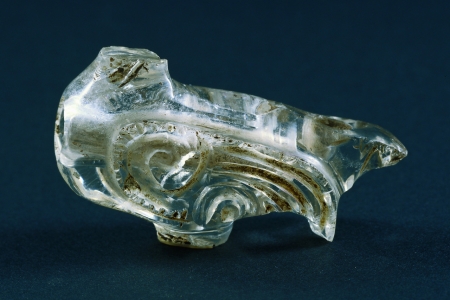The Art Lovers Who Founded Cairo 2018-03-18
The Fatimids created the first alternative Muslim empire to fully challenge the orthodox Sunni Caliphate and ran a highly civilized, assiduously cultured and tolerant outfit.
y Melik Kaylan
March 19, 2018 4:30 p.m. ET
0 COMMENTS
Toronto
In early Islamic history the Fatimids (909-1171) created the first alternative Muslim empire to fully challenge the orthodox Sunni Caliphate, which had become the faith’s mainstream, its Vatican equivalent, then based in Baghdad. Initiated by a Syrian imam who converted the Berber tribesmen of what is now Algeria, the Fatimids rolled eastward, founding Cairo where they established their capital. At the empire’s height, their sway ranged from western north Africa via Sicily to Yemen and the Levant. In the process they also created the Al-Azhar University, today the oldest such degree-giving institution in the world. Named after the Prophet’s daughter Fatima, the Fatimids embraced the lineage of the Shiite Ismaili faith from which the Aga Khan descends.
The World of the Fatimids
Aga Khan Museum
Through July 2
This being the current Aga Khan’s Diamond Jubilee year as leader of Ismaili Muslims around the world, it seems apt that the Aga Khan Museum in Toronto should dedicate a spacious show to the Fatimids. By all accounts, the Fatimids ran a highly civilized, assiduously cultured and tolerant outfit: libraries and patronage of the arts flourished; Jews and Christians acted as chief vizier at various times; and the populace worshiped as it wished. The operative phrase here is “by all accounts,” because the Fatimid era came to a sudden end when Saladin conquered Egypt for the Sunni Caliphate. He then presided over a very deliberate expunging of the Fatimid legacy—dispersing its library and manuscripts, its court poets and scholars; converting its mosques; destroying its artifacts and literature. So the extant accounts of the dynasty tend to depend on other sources, often hostile, and few artifacts survive to paint a complete picture of Fatimid life.
The show, gathered mostly from top-tier museums and private collections, is a rare offering and an archaeological detective story. And what an extraordinary revelation “The World of the Fatimids” proves to be. Upon entering, the visitor sees the three monotheistic religions juxtaposed: a glazed earthenware bowl depicting a Coptic priest; beyond it, a beautifully carved wooden Ismaili mihrab (Muslim prayer niche); and nearby the photo of a wooden synagogue door carving—all objects from Fatimid times. (The door is in a French museum, too fragile to travel.) Decorative motifs on both wood pieces indicate they likely came from a single workshop, ecumenical in its production. As the the show’s curator, Assadullah Souren Melikian-Chirvani, a renowned scholar of Islamic visual culture, explained in a press briefing, “as a small minority in their own territory the Fatimids chose to rule by consent and inclusion rather than mere power,” surrounded as they were by a preponderance of Copts, Jews, Armenians and Muslims of other sects. “Significantly, the Fatimids never referred to themselves as kings,” he added.
The show features some 90 artifacts and is composed mainly of ceramics, metalware, carved rock crystal (a Fatimid specialty), carved stone and calligraphy. “Each item,” says Mr. Melikian-Chirvani, “serves as a starting-point—you have to decipher its many layers.” And walking through the show, decoding the subtle signs, a distinct impression forms of Fatimid-era sensibilities: playful subversiveness and freedom of thought, with indulgence from the highest levels. A display of three earthenware bowls overpainted in gold and depicting hunting scenes sets the tone. One has a royal figure on horseback, a wry smile on his face. In another we see a lion and hare, natural enemies, simpering cartoonishly. In the third, the hunting cheetah sports a friendly grin.
Overall, they suggest court complicity in irreverence, mischief and soft power. Witness another bowl with the royal symbol of a winged lion at center, which must be turned upside down for the artist’s signature to be read. “This kind of inversion could amount to lèse-majesté—until you realize that the Fatimids encouraged self-deprecation and irony,” the curator said.
Wrapped in hermeneutic enigmas, the objects emanate a poignant mix of beauty and mystery. Perhaps the most beautiful and mystifying is the hand-sized rock-crystal crescent moon engraved with a Fatimid caliph’s name. It once adorned a Muslim preacher’s pulpit but was afterward mounted atop a 14th-century Christian reliquary from Germany. Mr. Melikian-Chirvani has even discerned at its center a little plaque of 15th-century Iranian silver. The entire object is no taller than 16 inches. Its history of dramas and travels down the ages remains a secret.
The most poignant exhibit, though, and the most strikingly monumental, must be the display of three 8-foot-wide white-marble slabs carved with royal symbols, likely made to decorate the Cairo palace walls. Fish, deer and peacocks sit amid arabesques of exquisite foliage but slowly lose form and peter out toward the edges, uncompleted. What caused the work to stop? The slabs were found centuries later, deliberately interred face-down in sand, practically the only testimony to the palace’s grandeur. All the evidence suggests that we are looking at a historic chronicle fixed in stone: the moment when the Fatimid dynasty abruptly ended.
—Mr. Kaylan writes about culture and the arts for the Journal.
- 3871 reads
 Ismaili.NET - Heritage F.I.E.L.D.
Ismaili.NET - Heritage F.I.E.L.D.